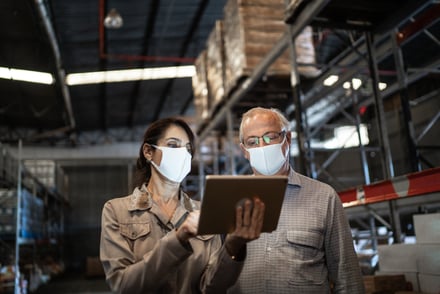“We have reached a time where planning for a safe return to normal activities has become a priority. Safe operation of HVAC and building water management systems are critical components of building readiness and reopening.”
ASHRAE President Darryl K. Boyce, P.Eng.
COVID restrictions in Australia are easing and governments in the key markets where EP&T Global operate are removing their lockdowns and other restrictions. Leading industry bodies in multiple countries are calling for a thoughtful and planned approach to the re-opening of buildings. Organisations such as ASHRAE (American Society of Heating, Refrigerating and Air-Conditioning Engineers), AIRAH (Australian Institute of Refrigeration, Air Conditioning and Heating) and others, have urged special caution when re-opening buildings. A big reason being that improperly or poorly maintained HVAC systems can contribute to spread of outbreaks like Legionella.
ASHRAE Epidemic Task Force chair, ASHRAE Environmental Health Committee voting member, and 2013-14 ASHRAE Presidential Member, Bill Bahnfleth stated, “Key elements of a strategy to limit the spread of the COVID-19 virus are to perform needed heating, ventilating and air conditioning (HVAC) system maintenance, including filter changes, and to run HVAC equipment prior to re-occupancy.” EP&T’s team of technical experts and analysts share this view and have been providing advice and guidance to customers around the world accordingly.
As building operators prepare to re-open their buildings, welcome tenants, and move closer to normal operations, we believe that sharing guidelines on some of the measures required to mitigate potential health risks is important.
Advice
Every building presents its own unique combination of health and efficiency challenges and opportunities. The suggestions described here are generic in nature and should be considered in the specific context of the purpose, technology, configuration, occupancy, climate, and other attributes of each building and building site.
EP&T’s engineers and analysts are dedicated to providing detailed intelligence, insight and advice to customers around the world as they seek to adapt to the changes presented by the COVID crisis. We believe commitment to partnership with our customers has never been more important.
If you haven't yet partnered with EP&T Global, reach out to us. Let's talk about how we can work together to optimise your building.
Ventilation and Health
A list of precautionary measures relating to HVAC systems, also endorsed by the likes of AIRAH, CIBSE, ASHRAE and REHVA (The Federation of European Heating, Ventilation and Air Conditioning Associations), includes:
- Maximise outside air supply to individual zones and increase ventilation rates (use caution in highly polluted areas and during extreme ambient conditions). Reduced occupancy helps increase the effective dilution ventilation per person.
- Toilet exhaust systems can be left on 24/7 (to reduce faecal-oral transmission risks).
- Minimise the use of rotary heat exchangers, including enthalpy wheels, as these can carry over particles (contaminants) from exhaust air to supply side through leaks. This is especially relevant in cases of poor design and maintenance activities.
- Temporarily disable demand-controlled ventilation (DCV) to minimise recirculation.
- Where possible, use more window airing.
- Further open min OA dampers to eliminate recirculation. In the mild weather, this need not affect thermal comfort or humidity, but should be revisited come Winters in the Southern Hemisphere and Summers in Northern Hemisphere.
- Avoid central recirculation by closing recirculation dampers. FCUs, for example, use local recirculation and where relevant can be turned off. If they can’t be turned off, clean them frequently.
- Improve air filtration (by using HEPA certified filters or the highest grade compatible with the filter rack). Ensure the edges of filters are sealed to limit air bypassing through the corners.
- Keep some ventilation assets running longer or at higher speed to increase ventilation rate and air change rates inside the buildings.
- Consider portable room air cleaners with HEPA filters. When in use, placed them close to the ‘breathing zone’.
- Consider UVGI (ultraviolet germicidal irradiation), protecting occupants from infection, particularly in high-risk spaces such as waiting rooms, prisons and shelters.
- According to REHVA, humidification doesn’t have any practical impact on the virus under the thermal comfort temperature and humidity ranges. It is susceptible only to a very high relative humidity (RH) above 80% and a temperature above 30°C.
- Adjust temperature setpoints to ‘unoccupied’ levels and expand the deadbands when a floor or zone is unoccupied. Operate the HVAC on those floors for only a couple of hours every day. This is required to eliminate problems like humidity levels affecting paints and carpets, smells, moulds, etc. when air conditioning is not operating.
- Update the cooling demand calculations to ensure the unoccupied spaces are not calling the plant to operate periodically. On days when outside air humidity is low, you would be better off enabling economy cycles on these floors in the early hours of the day.
- In buildings with multilevel carparks, some levels can temporarily be closed, and tenants/patrons can be advised to park on certain levels in the available slots rather than their designated spots.
- Increase the chilled water supply temperature setpoints. This is particularly helpful in buildings situated in the southern hemisphere as they can make use of economy cycles and free cooling.
- Restrict the number of available lifts, especially in buildings where occupancy levels are less than 25%.
- Inspect for leaking taps and toilets especially in tenant spaces.
- Review mechanical drawings to check the availability of floor isolation dampers and check whether select spaces can be isolated.
- For hotels, check the possibility of letting rooms on a selection of designated levels, allowing other levels to be temporarily shut off. These can be reactivated as occupancy increases.
- Given cooler weather conditions in the Southern Hemisphere, we recommend setting the outside air lockout to 20°C. This will assist with holding the plant off for a longer period and reduction of energy consumption.
- Turn off/dim the lighting on ‘unoccupied’ floors and their common areas (other than emergency lighting).
- Consider amending time schedules to start the plant 30 minutes prior to commencement of core business hours.
- Preventative maintenance activities, water treatment and cleaning, and scheduled inspections and testing should continue as normal to ensure continuity of operations and cleanliness.





